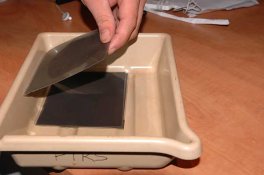leeturner said:
John, looking at your tubes is there a particular reason why you build them from two 5" lengths of pipe? I've seen some that have a cap that screws on to the male coupler. I'm going to attempt to make some this weekend and there are a few designs but yours look very straightforward to build. How much chemical do you recommend and, finally

, do you perform the fix stage under safelight as quite a few seem to do? I've tried tray developing but am not brave anough yet to tackle more than one sheet at a time and have lost my bearings more than once after 12 minutes in the dark. :rolleyes:
Hi Lee,
The reason I built pipes with two sections was so that the film could be put in one end and stay there during the entire process while the other end could hold the various chemicals. Here's my basic process (I use D-D23) ::
1) fill one half of the tube with developer (D23) and stand it up in a holder ( a 2x4 with a hole in it works nicely)
2) in the dark, put the negative in the other half, screw the negative end onto the chemical end and leave it standing up so that the negative stays dry. (see note #1)
3) turn on the lights
4) set your timer, put the tube assembly into a tempering bath (sink full of water at 20'C) let it float and gently roll it slowly in alternating directions for the required time
5)with the lights still on .... yes, you're reading correctly, unscrew the top (film half) half of the tubes assembly and set the film tube down so that the open end is downward on a towel or in the 2x4 stand (blocks the light)(see note #2)
6) dump and refill the chemical end with whatever (in my case, a Borax solution)
7) screw the two parts together and agitate in a water bath again
8) unscrew, set film end down on towel/in block (whatever) to block light
9) dump and refill chemical (stop bath or whatever ...)
I think you've got the idea now, so you just dump and refill until you're done. Once you're at the wash stage, fill the film tube with water and then pull the film out, throw it into the sink and let the tap run ever so slowly to give it a good wash - the sink shouldn't overflow as it likely has a drain hole at the top front to prevent accidents.
If you wanted to make the procedure even more easy, you could have a separate chemical tube end for each stage and then all you have to do is swap the film end from one tube to another without dumping.
I don;t worry about "how much" chemical to fill with as I re-use my D23 for months anyway ....
Note 1) : I do a water soak before any developing takes place - it makes for better development
Note 2) : once the film has been through the first stage (developer), it is desensitised enough that you don;t really have to worry about stray light - this information came direct from Ilford in case anyone wants to dispute it. The Ilford tech guy doesn't even try to block light during the stop/fixer stage, but I do, just in case.
cheers













